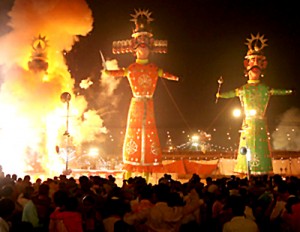
D
ussehra, or Vijayadashami, as many call it, is one of the most important festivals in India. In the northern Indian states, it’s called Dussehra, while in West Bengal, it’s called Vijayadashami.
Dusshera falls on the tenth day of Sharada Navratri. However, despite the fact that celebrations and cultural practices vary according to the location in India’s culturally rich country, the festival’s fabric that binds everyone together remains.
History
Dussehra symbolises the triumph of good over evil, and it is tied to two stories. After a fierce battle that lasted more than nine days, it is said that Maa Durga conquered Mahishasura on this day. According to another tale, Dussehra is observed to commemorate Lord Rama’s victory over Lanka’s ten-headed evil king, Ravana.
Significance
The tenth day of Navratri, which is comprised of nine days dedicated to honouring each form of Goddess Durga, is Dussehra. Vijayadashami, on the other hand, is the day of victory. While some connect it to the famous Ramayana conflict, others do it to remember Goddess Durga’s triumph over the demonic Mahishasura.
In some regions of the country, Dussehra, also known as Vijayadashami or Dasain, makes way for the Diwali celebrations.
Twenty days after Dussehra, one of the most significant and widely celebrated festivals, the festival of lights, Diwali, commemorates Lord Rama’s return home following his victory over Ravana. However, the main message of the Dussehra festival is that of good triumphing over evil, and it is on this day that people pray for prosperity and good health.
Celebrations
The nine days of Navratri culminate in the killing of Ravana and the burning of his life-size effigy at the Ramlila, together with those of Meghnad and Kumbhakaran, on the day of Dussehra, or Vijayadashami, when the holiday is celebrated with great grandeur.
As each of Ravana’s heads represents a different negative attribute, Dussehra also represents purging oneself of sins or undesirable traits.
In several southern Indian states, Shami Puja is also known as Banni Puja and Jammi Puja. Devotees wish Maa Durga farewell on Dashami, and the visarjan is performed either at Aparahna time or Pratahkala while Dashami Tithi is in effect.
The tenth day is also known as Vijayadashmi, when Maa Durga’s idol is submerged in water in the hopes that she will keep an eye on them and fend off all misfortunes and evils. Vijayadashmi and Dussehra commemorate the triumph of good over evil, and worshippers celebrate the festivals by indulging in various foods with their loved ones.